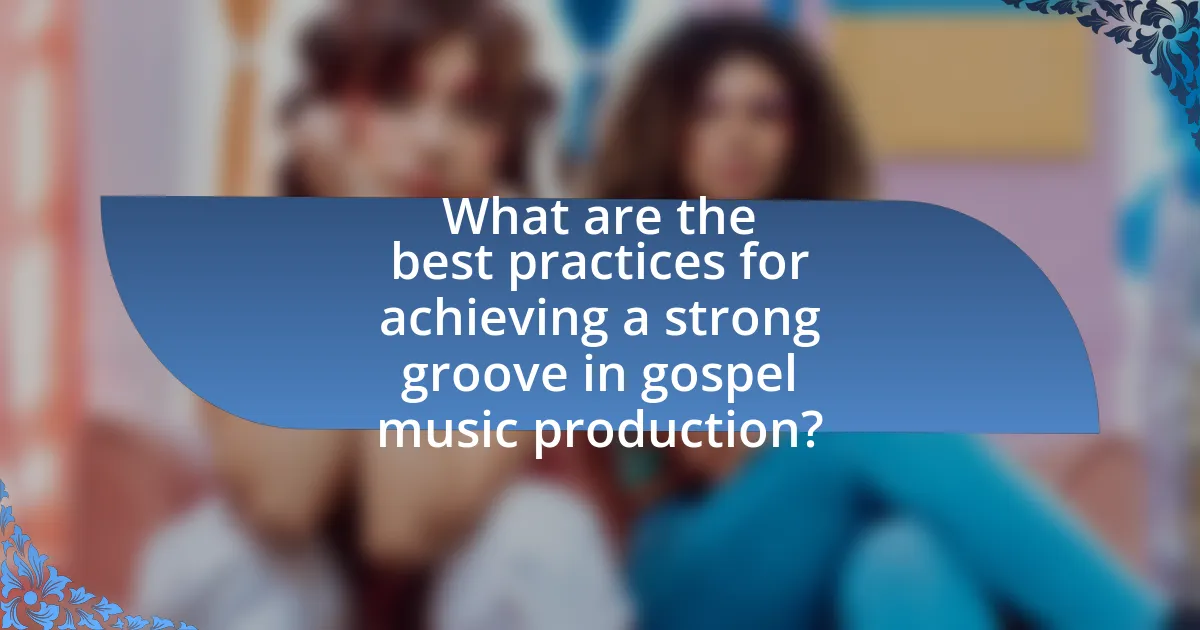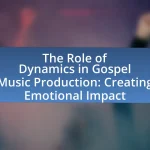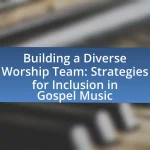The article focuses on the significance of tempo and groove in gospel music production, highlighting their roles in shaping the emotional and spiritual atmosphere of performances. It discusses how tempo influences the pace and energy of worship experiences, while groove establishes a rhythmic foundation that encourages audience participation. Key characteristics of tempo in gospel music, including its range and impact on different styles, are examined alongside the emotional effects of groove on congregational engagement. Additionally, the article outlines best practices for producers to manipulate tempo and achieve a compelling groove, emphasizing the importance of rhythmic coordination and interaction among musicians.

What is the significance of tempo and groove in gospel music production?
Tempo and groove are crucial elements in gospel music production as they establish the emotional and spiritual atmosphere of the performance. The tempo dictates the pace of the music, influencing the energy and intensity of the worship experience, while the groove creates a rhythmic foundation that encourages participation and movement among the congregation. Research indicates that a moderate tempo, typically between 70-100 beats per minute, is often used in gospel music to facilitate a reflective yet uplifting environment, allowing for both personal contemplation and communal engagement. The interplay of tempo and groove not only enhances the musicality but also reinforces the message of the lyrics, making the overall experience more impactful for the audience.
How do tempo and groove influence the overall feel of gospel music?
Tempo and groove significantly shape the overall feel of gospel music by establishing its rhythmic foundation and emotional intensity. The tempo, often ranging from slow ballads to upbeat anthems, dictates the pace at which the music is experienced, influencing the listener’s emotional response. For instance, a slower tempo can evoke feelings of reflection and reverence, while a faster tempo can create a sense of joy and celebration. Groove, defined as the rhythmic feel or swing of the music, enhances this emotional impact by encouraging movement and participation, often leading congregations to engage physically through clapping or dancing. Research indicates that the interplay of tempo and groove in gospel music not only affects individual enjoyment but also fosters communal worship experiences, as seen in the vibrant performances of artists like Kirk Franklin and the traditional sounds of choirs.
What are the defining characteristics of tempo in gospel music?
The defining characteristics of tempo in gospel music include a range of speeds that typically vary from slow, reflective ballads to fast, energetic rhythms. Gospel music often employs a tempo that enhances emotional expression, with slower tempos facilitating contemplation and faster tempos encouraging exuberance and participation. For instance, traditional gospel songs may have a tempo around 60-80 beats per minute for slower hymns, while up-tempo gospel songs can reach 120-140 beats per minute, promoting a lively atmosphere. This variability in tempo is crucial for conveying the spiritual message and engaging the congregation, as evidenced by the diverse styles found in gospel music, from soulful ballads to spirited praise songs.
How does groove contribute to the emotional impact of gospel music?
Groove significantly enhances the emotional impact of gospel music by creating a rhythmic foundation that engages listeners and encourages participation. This rhythmic quality fosters a sense of community and shared experience, which is essential in gospel music, often performed in congregational settings. Studies have shown that groove can evoke emotional responses, as the syncopated rhythms and steady beats resonate with the human body’s natural rhythms, promoting feelings of joy and spiritual upliftment. For instance, research published in the Journal of Music Theory indicates that groove influences listeners’ emotional states, making them more likely to connect with the music on a deeper level.
Why are tempo and groove essential for engaging the audience?
Tempo and groove are essential for engaging the audience because they create a rhythmic foundation that influences emotional response and participation. A well-defined tempo establishes the pace of the music, allowing listeners to connect with the beat, while groove adds a sense of movement and feel that encourages physical response, such as dancing or clapping. Research indicates that music with a strong groove can enhance listener enjoyment and increase the likelihood of audience interaction, as demonstrated in studies showing that participants are more likely to move to music with a compelling groove (Hove & Risen, 2009, “It’s All in the Timing: The Effects of Groove on Movement”). This connection between tempo, groove, and audience engagement is crucial in gospel music, where communal participation is a key element of the experience.
How do tempo and groove affect congregational participation in worship?
Tempo and groove significantly influence congregational participation in worship by creating an engaging atmosphere that encourages active involvement. A faster tempo often energizes the congregation, prompting movement and vocal participation, while a slower tempo can foster reflection and a sense of reverence. Research indicates that songs with a strong groove enhance the likelihood of congregants singing along and clapping, as they feel a rhythmic connection to the music. For example, studies show that congregations are more likely to participate when the music aligns with their emotional state and cultural background, demonstrating that both tempo and groove are critical in facilitating a communal worship experience.
What role do tempo and groove play in creating a memorable worship experience?
Tempo and groove are essential in creating a memorable worship experience as they influence the emotional engagement and participation of the congregation. A well-chosen tempo can evoke specific feelings, with slower tempos often fostering reflection and intimacy, while faster tempos can energize and uplift the spirit. Groove, defined as the rhythmic feel or swing of the music, enhances the connection between musicians and worshippers, encouraging movement and interaction. Research indicates that music with a strong groove can lead to increased physical response, such as swaying or clapping, which reinforces communal worship. This dynamic interaction between tempo and groove ultimately shapes the overall atmosphere, making the worship experience more impactful and memorable.

How do different tempos affect gospel music styles?
Different tempos significantly influence gospel music styles by shaping the emotional delivery and rhythmic feel of the songs. For instance, slower tempos often create a reflective and worshipful atmosphere, allowing for deep lyrical contemplation, while faster tempos tend to evoke joy and celebration, encouraging congregational participation and movement. Research indicates that tempo variations can alter the listener’s emotional response; a study published in the Journal of Music Therapy found that slower music can enhance feelings of calmness, while faster music can increase energy levels and engagement. Thus, the choice of tempo is crucial in determining the overall impact and effectiveness of gospel music in conveying its spiritual messages.
What are the common tempos used in various gospel music genres?
Common tempos in various gospel music genres typically range from 60 to 120 beats per minute (BPM). For example, traditional gospel often features slower tempos around 60-80 BPM, allowing for reflective worship, while contemporary gospel may utilize faster tempos of 100-120 BPM to encourage energetic praise and movement. Additionally, gospel choirs often perform at moderate tempos, around 80-100 BPM, to balance vocal harmonies with rhythmic drive. These tempo ranges are consistent with the emotional and spiritual expressions found in gospel music, supporting both solemnity and celebration.
How does a slow tempo enhance the message in traditional gospel music?
A slow tempo enhances the message in traditional gospel music by allowing for deeper emotional expression and reflection. This deliberate pacing gives singers and listeners the opportunity to absorb the lyrics’ spiritual significance, fostering a contemplative atmosphere that encourages personal connection to the themes of faith, hope, and redemption. Research indicates that slower tempos can evoke feelings of solemnity and introspection, which are essential in conveying the profound messages often found in gospel music. For instance, studies in music psychology show that slower rhythms can lead to increased emotional engagement, making the spiritual messages more impactful for the audience.
What impact does a fast tempo have on contemporary gospel music?
A fast tempo in contemporary gospel music enhances energy and engagement among listeners and performers. This increased tempo often leads to a more vibrant and uplifting atmosphere, encouraging participation through clapping, dancing, and singing along. Research indicates that faster tempos can elevate mood and create a sense of urgency, which aligns with the celebratory nature of many gospel themes. For instance, songs like “Every Praise” by Hezekiah Walker utilize a brisk tempo to foster communal worship experiences, demonstrating how tempo directly influences the emotional and spiritual impact of the music.
How can producers effectively manipulate tempo in gospel music?
Producers can effectively manipulate tempo in gospel music by utilizing tempo changes, layering rhythmic elements, and employing digital audio workstations (DAWs) for precise control. Tempo changes can create dynamic shifts that enhance emotional impact, as seen in many gospel tracks where slower verses transition to faster, uplifting choruses. Layering rhythmic elements, such as claps or percussive instruments, can add depth and drive to the music, allowing for a more engaging listening experience. Additionally, DAWs provide tools for adjusting tempo without altering pitch, enabling producers to experiment with different speeds while maintaining the integrity of the vocal performances. This approach is supported by the fact that tempo variations can significantly influence the energy and feel of a song, which is crucial in gospel music to evoke spiritual responses.
What techniques can be used to achieve the desired tempo in production?
To achieve the desired tempo in production, producers can utilize techniques such as tempo mapping, click tracks, and rhythmic layering. Tempo mapping involves adjusting the tempo throughout a track to match the emotional dynamics of the music, ensuring that the pace aligns with the intended feel. Click tracks provide a consistent metronomic reference for musicians, helping them maintain a steady tempo during recording sessions. Rhythmic layering adds depth by combining various rhythmic elements, which can enhance the overall groove and feel of the production. These techniques are essential in gospel music production, where the tempo significantly influences the emotional impact and engagement of the audience.
How does tempo adjustment affect the arrangement of gospel songs?
Tempo adjustment significantly influences the arrangement of gospel songs by altering the emotional impact and energy level of the music. When the tempo is increased, gospel arrangements often become more lively and energetic, encouraging participation and uplifting the congregation. Conversely, a slower tempo can create a more reflective and worshipful atmosphere, allowing for deeper contemplation and connection to the lyrics. Research indicates that tempo variations can affect listeners’ emotional responses, with faster tempos typically associated with feelings of excitement and joy, while slower tempos evoke calmness and introspection. This dynamic interplay of tempo and arrangement is crucial in gospel music, as it directly shapes the worship experience and enhances the overall message conveyed through the songs.

What are the best practices for achieving a strong groove in gospel music production?
To achieve a strong groove in gospel music production, it is essential to focus on tight rhythmic coordination among instruments and vocalists. This involves ensuring that the rhythm section, including drums and bass, locks in together to create a solid foundation. Additionally, utilizing syncopation can enhance the groove by adding rhythmic interest and complexity, which is a hallmark of gospel music.
Incorporating dynamic variations in volume and intensity can also contribute to a compelling groove, as it engages listeners and encourages participation. Furthermore, maintaining a consistent tempo is crucial; using a metronome during practice and recording sessions can help musicians stay in sync.
Research indicates that groove perception is closely linked to the timing and interaction of musical elements, as highlighted in the study “The Role of Groove in Music” by Janata et al. (2012), which emphasizes the importance of rhythmic precision in creating an engaging musical experience.
How can musicians create a compelling groove in their arrangements?
Musicians can create a compelling groove in their arrangements by focusing on rhythmic consistency, syncopation, and interaction between instruments. Establishing a strong rhythmic foundation, often through a steady bass line and drum pattern, allows the groove to resonate. Syncopation, which involves placing emphasis on off-beats, adds complexity and interest, making the groove more engaging. Additionally, the interplay between instruments, such as call-and-response patterns or complementary rhythms, enhances the overall groove. Research indicates that grooves with a clear rhythmic structure and dynamic interaction can significantly enhance listener engagement and emotional response, as seen in various studies on music perception and rhythm.
What instruments are most effective in establishing groove in gospel music?
The most effective instruments in establishing groove in gospel music are the drums, bass guitar, and keyboard. The drums provide a rhythmic foundation that drives the tempo, while the bass guitar adds depth and syncopation, creating a compelling groove. Keyboards, often used for chords and melodic lines, enhance the harmonic structure and contribute to the overall feel of the music. Together, these instruments create a cohesive rhythmic and melodic framework essential for the groove in gospel music, as evidenced by their prominent roles in traditional and contemporary gospel arrangements.
How does rhythm section interplay contribute to the overall groove?
Rhythm section interplay significantly enhances the overall groove by creating a cohesive and dynamic foundation for the music. This interplay involves the synchronization of instruments such as drums, bass, and rhythm guitar, which together establish a rhythmic framework that drives the tempo and feel of the piece. For instance, in gospel music, the bass often locks in with the kick drum to form a solid pulse, while the snare and hi-hat provide accents that add complexity and texture. This tight coordination allows for a more engaging and infectious groove, encouraging movement and participation from the audience. Studies in music theory highlight that effective rhythm section interplay can increase listener engagement and emotional response, underscoring its critical role in the overall musical experience.
What common challenges do producers face with tempo and groove?
Producers commonly face challenges with tempo and groove, primarily due to the difficulty in achieving a cohesive rhythmic feel that aligns with the emotional intent of the music. This challenge often arises from the need to balance varying tempos across different instruments while maintaining a consistent groove that resonates with the genre’s spiritual essence. Additionally, producers may struggle with quantization issues, where the timing of recorded elements can feel mechanical rather than organic, impacting the overall feel of the track. The complexity of gospel music, which often incorporates syncopation and polyrhythms, further complicates these challenges, making it essential for producers to have a deep understanding of rhythm and its emotional implications in the context of gospel music.
How can producers troubleshoot issues related to tempo consistency?
Producers can troubleshoot issues related to tempo consistency by utilizing a metronome during recording sessions to ensure all instruments align with the intended tempo. This method allows for real-time adjustments and helps identify any discrepancies in timing among musicians. Additionally, producers should analyze recorded tracks using digital audio workstations (DAWs) to visually inspect waveforms for tempo irregularities, enabling precise editing to correct any inconsistencies. Research indicates that maintaining a steady tempo is crucial for the overall groove and feel of gospel music, as it enhances the emotional impact and listener engagement.
What strategies can be employed to enhance groove during recording sessions?
To enhance groove during recording sessions, musicians should focus on tight rhythmic coordination and consistent tempo. Implementing a metronome or click track ensures that all instruments maintain a steady pace, which is crucial for creating a cohesive sound. Additionally, encouraging musicians to lock into each other’s rhythms through call-and-response techniques can foster a more dynamic groove. Research indicates that groove perception is significantly influenced by the timing and interaction between musicians, as highlighted in the study “The Role of Timing in Groove” by Janata et al. (2012), which emphasizes the importance of rhythmic alignment in music performance.
What practical tips can enhance tempo and groove in gospel music production?
To enhance tempo and groove in gospel music production, musicians should focus on using a metronome during practice sessions to establish a consistent tempo. This tool helps maintain rhythmic accuracy, which is crucial in gospel music where timing can significantly affect the overall feel. Additionally, incorporating syncopation in arrangements can create a more dynamic groove, as it adds rhythmic interest and engages listeners. Research indicates that gospel music often relies on complex rhythms, and utilizing techniques like call-and-response can further enhance the groove by encouraging interaction among musicians and the audience. Furthermore, layering instruments with varying rhythmic patterns can create a fuller sound, contributing to a rich, engaging groove that is characteristic of gospel music.


